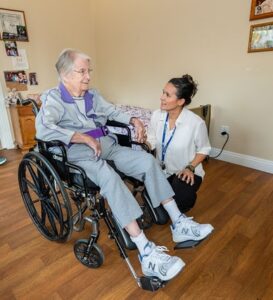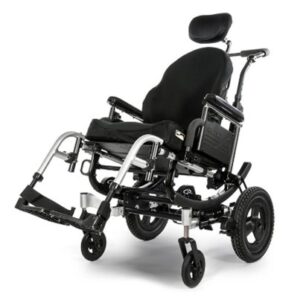One of the principal goals for our senior patients is to improve their quality of life. Therefore, assessing the adaptive equipment they are using is important. There are many specialized choices to improve functionality, comfort, and safety.
Wheelchairs often present a challenge for patients and their families. A properly configured wheelchair will meet a patient’s specific needs while a standard wheelchair will be lacking. When choosing a custom wheelchair, a therapist will target any possible issues before the chair arrives, then fine tune it. Therapy will be needed after the chair has been received, for the most comfortable positioning and safety. A custom wheelchair can be recommended by a physical or occupational therapist. Here is why…
Proper positioning in the wheelchair is required so the patient doesn’t slump over, shift their weight excessively due to discomfort or slide forward and possibly fall out of the chair. Correct posture is also important for good breathing and swallowing, especially when eating. For example, some patients are at risk of aspiration if they are not positioned correctly in their wheelchair during meals.
Positioning starts at the pelvis. If a patient experiences discomfort or had a stroke, the patient may laterally lean to one side without proper support from the wheelchair. The trunk muscles will conform to this lateral lean over time. A therapist will work to stretch and strengthen the truck muscles and all other body parts for midline sitting even before their custom wheelchair arrives.
Key points for positioning in wheelchair
- Hips/pelvis
- Bottom all the way back in chair
- Centered within confines of the wheelchair
- Top of pelvis should be level
- Knees should be even
- Trunk or chest
- Positioned in the middle of the backrest without leaning to one side
- Head
- Positioned in the middle, not leaning to one side
- Legs and feet
- Thighs and legs should be parallel
- Knees level with hips
- Feet should make full contact on footplate
- Arms
- The height of the armrest should be adjusted so the shoulders are relaxed and the arms are supported
Check out this great reference for more information on wheelchair positioning
https://www.myshepherdconnection.org/sci/wheelchair-positioning
Once a custom wheelchair is delivered, how does a therapist help? A therapist will work on ensuring the chair meets the patient’s expectations and that their body is positioned properly. An assessment will be made for undue pressure at specific points on the body; common areas that can lead to skin breakdown. In addition, the therapist will train the patient and caregivers on how to use the chair and transfer in and out of the chair, if appropriate. The ultimate goal is to build sitting tolerance and comfort. This increases the time the patient can be out of bed, participating in activities, meals and observing their environment.
Pressure Sores
Another consequence of an improperly fitted wheelchair is the development of pressure sores. We see 4 stages of skin breakdown in our patients, all requiring different treatments. The first stage will show as redness on the sacrum. If the pressure continues, the patient will develop an open sore. An open sore can be followed by a deeper wound. The painful 4th stage is a full wound, right down to the tendon or bone.
A therapist will use custom cushions depending on the stage, to off-load certain areas of the body, promote correct pelvic bone angle and take pressure away from the tail bone. Custom back cushions can also adjust pressure towards the patient’s back, and away from the tailbone.
What type of custom wheelchair should be considered? There are many options, but first and foremost it is important to be comfortable in the chair. One of my favorite wheelchairs, when patients cannot propel themselves, is the tilt-in-space wheelchair. A tilt-in-space wheelchair is designed to provide very specific benefits for both the wheelchair user and the caregiver. Users with insufficient strength to reposition themselves can be tilted easily by a caregiver to provide an effective weight shift or for easier repositioning in the wheelchair. I would not recommend a reclining back wheelchair as it produces more shear forces on the sacrum, which is a common place for pressure soars to develop. A tilt-in-space wheelchair maintains the hip and pelvis at a 90-degree angle.
At Mobile PT we provide tailor-made therapy. Issues are discussed and considered by the therapist, whose goal it is to keep patients healthy and happy. A customized therapy treatment includes having the right equipment.
Stay Strong!
Dan Sheehy is a Physical Therapist and the owner of Mobile PT, based in San Diego’s North County. Mobile PT strives to keep seniors strong and secure, decreasing fear and risk of falling. Our mission is to keep seniors confident and safe where they live to maximize their quality of life and maintain their independence.




Leave A Comment